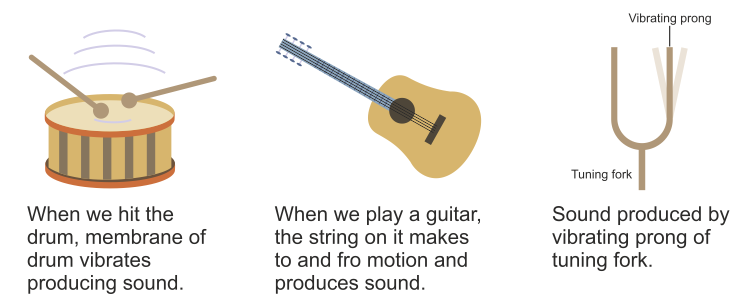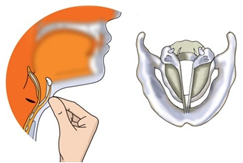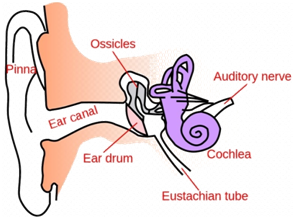Concepts
- Sound is a form of energy that helps us communicate with each other. It causes a sensation of hearing in our ears.
- Production of Sound:
(i) Sound is produced due to the vibration of object.
(ii) The motion of materials or objects causes vibration.
(iii) Vibration is a kind of rapid to and fro motion of an object a central position. It is also referred to as oscillation. - All vibrating bodies produce sound.

For Examples:
(a) A stretched rubber band when plucked vibrates and produces sound.
(b) In the music room of your school you hear the sounds made by musical instruments like flute, tabla, harmonium, guitar etc. because of vibration.
(c) When a spoon is beaten on the plate, it starts vibrating and produces sound.
- Sound Produced by Humans:
(i) In humans sound is produced because of vibration of his voice box or larynx.
(ii) It is situated at the upper end of windpipe. There are two stretched membranes called vocal cords attached in larynx with a narrow slit between them for passes air.

(iii) Muscles attached to the vocal cords can make the cords tight or loose. When the vocal cords are tight and thin, produce different type or quality of voice.
- Propagation of Sound:
(i) The travelling of sound is called propagation of sound.
(ii) Sound is propagated by the to and fro motion of particles of the medium.Sound needs a medium to propagate:
(i) A medium is necessary for the propagation of sound waves.
(ii) The matter or substance through which sound is transmitted is called a medium. The medium can be solid, liquid or gas.
(iii) Sound cannot travel in vacuum. A true vacuum refers to the complete absence of matter. Sound wave can travel only through matter. So, sound needs a physical medium in order to propagate anywhere.
(iv) We hear sound which comes to us through air medium particles.
(v)Aquatic animals communicate as sound travels through water.We hear Sound through Our Ears:

(i) The funnel shaped outer ear collects the sound. The sound wave passes through the ear canal to thin and stretched membrane called eardrum or tympanum. The ear drum vibrates and produces vibrations.
(ii) The vibrations are amplified by the three bones of the middle ear called hammer, anvil and stirrup. The middle ear then transmits the sound wave to the inner ear.
(iii) In the inner ear the sound wave converted into electrical signals by cochlea and send to the brain through the auditory nerves. The brain interprets the signals as sound. That is how we hear.
Amplitude, Time Period and Frequency of a Sound:
(i) Sound is produced by to and fro motion of an object is known as vibration. This motion is also called oscillatory motion.
(ii) Sound propagates from one place to another in the form of waves, i.e. because of the disturbance of particles of the medium.
(iii) Wave is a phenomenon or disturbance in which energy is transferred from one point to another without any direct contact between the points. So, sound is considered as a wave.
1. Amplitude:
(i) In a sound wave, the maximum displacement associated with the particle constituting a wave is called its amplitude.
(ii) It is represented by ‘A’. SI unit is meter.
2. Frequency:
(i) The number of vibrations and osscillations completed by an object in one second is the frequency of the sound.
(ii) Frequency = Number of Oscillation/ Total time
ⱱ = 1/T
(iii) Frequency is expressed in hertz. It is represented by Hz.
(iv) A frequency of 20 Hz is twenty oscillation per second.
(v) If an object oscillates or vibrates 80 times in 1 second, then its frequency will be equal to 80 hertz.
From above figure waves have same amplitude but number of vibrations in one second are different. So their frequencies are different.
3. Time period:
(i) The time taken by object or the particle of the medium for completing one oscillation or vibration is called the time period.
(ii) It is represented by ‘T’. SI unit is Second.
(iii) Time period = Time/ Numbers of oscillation or vibration.
T=1/f and f=1/T
Time period and frequency are reciprocals of each other.
Loudness and Pitch:
1. Loudness:
(i) Loudness of sound is the measure of sound energy reaching the ear per second.
(ii) Loudness or softness of a sound depends upon its amplitude.
(iii) Loudness of sound is proportional to the square of the amplitude of the vibration producing the sound.
Loudness α (Amplitude) x2
If the amplitude becomes twice, the loudness increases by a factor of 4.
(iv) Loudness of sound is measured in decibel (dB).
The following table gives different types loudness of sound coming from various sources.
Normal breathing 10 dB
Soft whisper (at 5m) 30dB
Normal conversation 60dB
Busy traffic 70dB
Average factory 80dB
2. Pitch or Shrillness:
(i) Pitch is the sensation (Brain interpretation) of the frequency of an emitted sound.
(ii) The pitch of sound (Shrillness or flatness) depends on the frequency of vibration.
(iii) Sound with greater frequency is shriller and has higher pitch. Sound with lower frequency is less shrill and of lower pitch.
Examples:
(i) Children and women produce high frequency sound so their sound is shriller or higher pitch. On the other hand, an adult male produces lower frequency sound so his sound is less shrill or lower pitch.
(ii) A drum produces lower frequency sound which is less shrill or lower pitch, while a whistle produces higher frequency sound which is shriller or higher pitch.
Audible and Inaudible Sound:
(i) Sounds of frequency range between 20 Hz to 20,000 Hz are called audible sound. The human beings can hear the sound range between 20 hertz to 20,000 hertz.
(ii) Sound of frequency below 20 hertz and above 20,000 hertz is called sound of inaudible range. Humans cannot hear the sound of inaudible range.
(iii) Many animals, such as dogs, cats, etc. can hear the sound with frequency above 20,000 hertz.
Noise and Music:
1. Noise: It is the sound that is unpleasant to hear. (E.g., Sound produced by vehicles)
2. Music: It is the sound that is pleasant to hear. (E.g., Sound coming out of musical instruments)
Noise Pollution:
(i) Presence of excessive, loud, unwanted or unbearable sound to our ears sounds in the environment is called noise pollution.
(ii) Examples: sounds of vehicles, explosions including bursting of crackers, machines, loudspeakers, television with high volume, loudspeakers etc
Problems due to Noise Pollution:
(i) Due to noise pollution many types of health related problems occurs, such as lack of sleep (insomnia), hypertension (High blood pressure), loss of hearing, anxiety, etc. Sound above 80 dB is very painful to hear.
(ii) A person who is exposed to loud sound continuously may get permanent or temporary impairment of hearing or loss of hearing.
Measures to Limit Noise Pollution:
Noise can be limited or controlled by controlling the noise source. Noise pollution can be controlled by taking following steps:
(i) TV, radio or loudspeakers should be played at low volume.
(ii) By installing high quality silencing devices in vehicles, air craft engines, industrial machines and home appliances.
(iii) We should not use loud vehicle horns.
(iv) Noise producing industries should be set up away from residential areas.
(v) Trees absorb sound. So plantation of trees should be done along the road sides and around buildings
(vi) Awareness campaign and noisy operations should be done to make people aware about the harmful effects of noise pollution and measures to control noise pollution.

